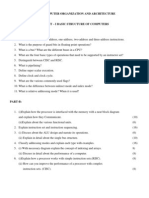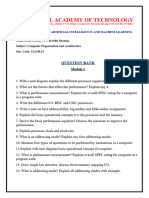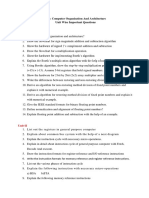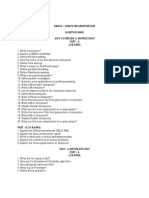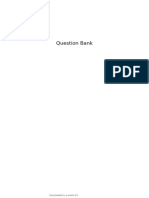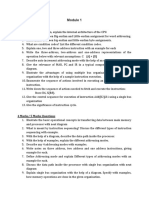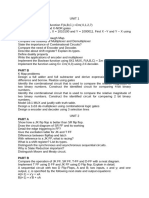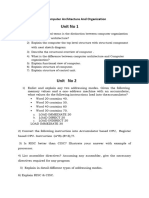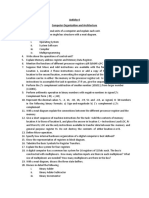0 ratings0% found this document useful (0 votes)
3 viewsPRACTICE QUESTIONS (LDCA)
Ldca important
Uploaded by
heya252005Copyright
© © All Rights Reserved
Available Formats
Download as DOCX, PDF, TXT or read online on Scribd
0 ratings0% found this document useful (0 votes)
3 viewsPRACTICE QUESTIONS (LDCA)
Ldca important
Uploaded by
heya252005Copyright
© © All Rights Reserved
Available Formats
Download as DOCX, PDF, TXT or read online on Scribd
You are on page 1/ 3
What are the roles of ALU?
What is the function of sequence counter?
What is Restoring division algorithm?
Differentiate between RISC and CISC instructions with help of example.
Explain the IEEE standard for floating-point numbers and also represent (1460.125)
using the single and double precision of IEEE representation.
Why the array multiplier is useful? Also, perform the multiplication of (-5) X (-7) &
using Booth’s algorithm.
Describe Instruction Format. Explain Carry Look Ahead Adder.
Explain non restoring and comparison algorithm used in division.
Discuss the key points of division algorithm and perform the division operation of
01110 by 10001 using division algorithm.
Draw and discuss Pipelining.
What are the functions of ALU and Control Unit?
What is the function of Stack Pointer and Program Counter?
Explain the architecture of a system bus with a detailed description of the data,
address, and control buses. What are functions of a control unit? Draw control unit
with all its functionalities.
What is bus arbitration? Describe the various bus arbitration techniques, including
daisy chaining, polling, and independent request methods.
What is system bus? Draw its architecture and explain the different types of buses
with their functions.
Draw the basic functional units of a computer and explain each of them.
What is bus arbitration? Describe the various bus arbitration techniques, including
daisy chaining, polling, and independent request methods.
With the help of proper block diagram explain the bus transfer using multiplexer.
Explain the different types of addressing modes with its suitable example.
Explain the push and pop operations of register stack and memory stack with the help
of a diagram.
Explain the need of page replacement algorithm. Consider the page reference string
5,0,1,2,0,3,2,0,3,4,1,0,5,0,4,3,2,1,2,0,1 with 3-page frames. Find number of page
faults using LRU page replacement algorithm.
With proper diagram explain Memory Hierarchy and Differentiate between ROM and
RAM.
How the mapping is done between cache and main memory? Explain at least two
methods of mapping. Explain various replacement algorithms in set-associative cache.
Explain the First-In-First-Out (FIFO) page replacement algorithm with an example.
Explain the chip interconnections when 1024 X 8 memory is constructed using 128 X
8 RAM chips and 512 X 8 ROM chips.
Explain the working of a semiconductor RAM with help of block diagram and
function table.
Explain the terms cache hit and cache miss. How do they influence system
performance?
How does an SSD work and what are the components involved in its operation?
Differentiate between the DRAM and SRAM.
Define the term hit ratio and its significance in the context of memory hierarchy.
Explain the working of 4:1 MUX and 1:4 DEMUX.
Explain the working of 4 to 2 encoder and 2 to 4 decoder.
Explain the construction and working of JK flip flop in detail.
What is Latch? Explain SR Latch in detail.
Explain the various types of counters.
Explain the various types of sequential circuits.
Explain AND, NOR and XOR logic gates with the help of diagram and truth table.
Explain the working and truth table of full adder.
What do you mean by register and enlist its types?
Explain the need of strobe control and Handshaking and also draw its timing
diagram.
Write short notes on: - (i) Parallel processing and (ii) Serial Communication.
Describe the different types of pipeline hazards. How do these hazards impact the
performance of pipelined processors?
Discuss the concept of Direct Memory Access (DMA). How does DMA improve
data transfer speeds and system performance?
How can pipeline hazards be resolved or minimized?
Why parallel processing is important?
You might also like
- Global Academy of Technology: Question Bank100% (1)Global Academy of Technology: Question Bank6 pages
- 21CS34 SIMP Questions - 21SCHEME: Module-1 (Study Any 5 Questions)No ratings yet21CS34 SIMP Questions - 21SCHEME: Module-1 (Study Any 5 Questions)4 pages
- Unit-I: Sub: Computer Organisation and Architecture Unit Wise Important QuestionsNo ratings yetUnit-I: Sub: Computer Organisation and Architecture Unit Wise Important Questions5 pages
- Cs2253 - Computer Architecture 16 Marks Question Bank With Hints Unit - I 1. Explain Basic Functional Units of Computer. Input UnitNo ratings yetCs2253 - Computer Architecture 16 Marks Question Bank With Hints Unit - I 1. Explain Basic Functional Units of Computer. Input Unit18 pages
- Question Bank: Rajalakshmi Engineering CollegeNo ratings yetQuestion Bank: Rajalakshmi Engineering College5 pages
- Cs6303 - Computer Architecture Question Bank Unit-I Overview & Instructions Part - A (2 MARKS)No ratings yetCs6303 - Computer Architecture Question Bank Unit-I Overview & Instructions Part - A (2 MARKS)4 pages
- Ec53 - Computer Architecture and OrganizationNo ratings yetEc53 - Computer Architecture and Organization7 pages
- II B.Tech I Semester: Academic Dairy For Computer OrganizationNo ratings yetII B.Tech I Semester: Academic Dairy For Computer Organization8 pages
- Suggestion On Computer Organization & Architecture (CS401)No ratings yetSuggestion On Computer Organization & Architecture (CS401)4 pages
- Lovely Professional University, Punjab: /lecture-Notes/lecture-29.pdf DFNo ratings yetLovely Professional University, Punjab: /lecture-Notes/lecture-29.pdf DF11 pages
- 12250H13 - Advanced Computer Architecture: LTPC 4 0 0 4No ratings yet12250H13 - Advanced Computer Architecture: LTPC 4 0 0 48 pages
- COA - Question Bank - Descriptive - New - 2021 - 22No ratings yetCOA - Question Bank - Descriptive - New - 2021 - 225 pages
- Practical Reverse Engineering: x86, x64, ARM, Windows Kernel, Reversing Tools, and ObfuscationFrom EverandPractical Reverse Engineering: x86, x64, ARM, Windows Kernel, Reversing Tools, and ObfuscationNo ratings yet
- (Allocation Unit Size FAT32 Explained) What Allocation Unit Size Should I Use For FAT32 - EaseUSNo ratings yet(Allocation Unit Size FAT32 Explained) What Allocation Unit Size Should I Use For FAT32 - EaseUS13 pages
- Optiplex 3040 - Small Form Factor: Owner'S ManualNo ratings yetOptiplex 3040 - Small Form Factor: Owner'S Manual46 pages
- JNTUA-R20-B.Tech - .-Civil-Engineering-III-IV-Year-syllabus (1) - RemovedNo ratings yetJNTUA-R20-B.Tech - .-Civil-Engineering-III-IV-Year-syllabus (1) - Removed2 pages
- Btech Cse 3 Sem Computer Organisation Pcc Cs302 2024No ratings yetBtech Cse 3 Sem Computer Organisation Pcc Cs302 20241 page
- Which Resources Are Typically Provided by An Infrastructure As A Service Cloud Computing Delivery ModelNo ratings yetWhich Resources Are Typically Provided by An Infrastructure As A Service Cloud Computing Delivery Model7 pages
- B1.1+Boeing+737-600 700 800 900+ (CFM+56) +70+Standart+PracticesNo ratings yetB1.1+Boeing+737-600 700 800 900+ (CFM+56) +70+Standart+Practices33 pages
- (Esquemas) Lenovo 3000 Y410compal - La-3571p - Rev - 0.1No ratings yet(Esquemas) Lenovo 3000 Y410compal - La-3571p - Rev - 0.148 pages
- Module 3 Installation of Hardware Components Part 45No ratings yetModule 3 Installation of Hardware Components Part 453 pages

